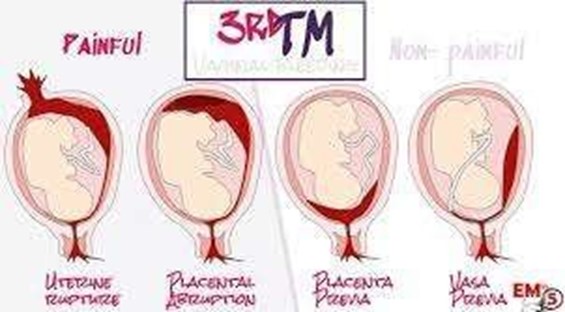A nurse is caring for a client who has a placenta previa.
Which of the following findings should the nurse expect?
Painless, vaginal bleeding.
Persistent headache.
Uterine hypertonicity.
Firm, rigid abdomen.
The Correct Answer is A
This is the most common symptom of placenta previa and can occur after 20 weeks of gestation.

Choice B is incorrect because a persistent headache is not a known symptom of placenta previa.
Choice C is incorrect because uterine hypertonicity is not a known symptom of placenta previa.
Choice D is incorrect because a firm, rigid abdomen is not a known symptom of placenta previa.
Nursing Test Bank
Naxlex Comprehensive Predictor Exams
Related Questions
Correct Answer is C
Explanation
A nurse should report absent deep-tendon reflexes to the provider when a client is receiving magnesium sulfate via continuous IV infusion.
This is because reduced tendon reflexes can be a side effect of magnesium sulfate use during pregnancy.
Choice A is not correct because a decrease in the frequency of contractions is an expected outcome of magnesium sulfate use as a tocolytic to stop preterm labor.
Choice B is not correct because a urinary output of 35 mL/hr is within the normal range.
Choice D is not correct because an elevated blood pressure is not a known side effect of magnesium sulfate use during pregnancy.
Correct Answer is A, B, C, D
Explanation
The correct answer is A, B, C, D.
The nurse should plan to perform the following actions in this order:
A. Ask the client to lie on her back and with her knees flexed.
B. Position one hand around the top of the client’s fundus and one hand just above the client’s symphysis pubis.
C. Rotate the upper hand to massage the client’s uterus while using slight downward pressure to compress the fundus.
D. Observe the client’s perineum for the passage of clots and the amount of
bleeding.
Fundal massage is performed to stimulate uterine contractions and prevent
postpartum hemorrhage.

Whether you are a student looking to ace your exams or a practicing nurse seeking to enhance your expertise , our nursing education contents will empower you with the confidence and competence to make a difference in the lives of patients and become a respected leader in the healthcare field.
Visit Naxlex, invest in your future and unlock endless possibilities with our unparalleled nursing education contents today
Report Wrong Answer on the Current Question
Do you disagree with the answer? If yes, what is your expected answer? Explain.
Kindly be descriptive with the issue you are facing.
